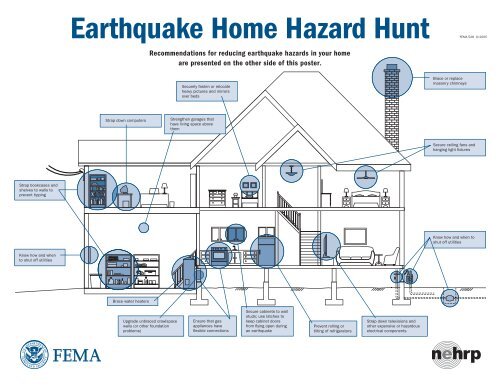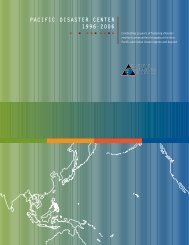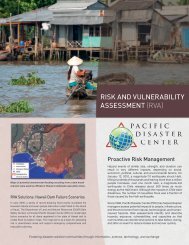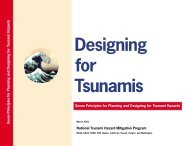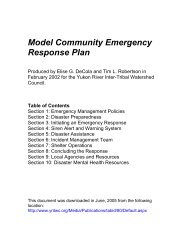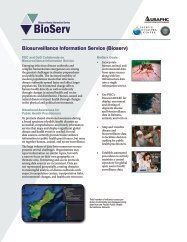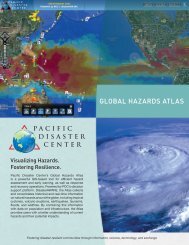FEMA 528 - Earthquake Home Hazard Hunt - Pacific Disaster Center
FEMA 528 - Earthquake Home Hazard Hunt - Pacific Disaster Center
FEMA 528 - Earthquake Home Hazard Hunt - Pacific Disaster Center
You also want an ePaper? Increase the reach of your titles
YUMPU automatically turns print PDFs into web optimized ePapers that Google loves.
<strong>Earthquake</strong> <strong>Home</strong> <strong>Hazard</strong> <strong>Hunt</strong><br />
Recommendations for reducing earthquake hazards in your home<br />
are presented on the other side of this poster.<br />
<strong>FEMA</strong> <strong>528</strong> 9/2005
<strong>Earthquake</strong> <strong>Home</strong> <strong>Hazard</strong> <strong>Hunt</strong><br />
This poster has information for you and your family to help you find and fix areas<br />
of your home that might be damaged in an earthquake and that might injure<br />
family members during an earthquake. Information is also provided on planning<br />
for an earthquake and safety steps you can take during and after an earthquake.<br />
Your earthquake home hazard hunt should begin with all family members participating.<br />
Foresight, imagination, and common sense are all that are needed as<br />
you go from room to room imagining what would happen if the earth and house<br />
started shaking. Anything that can move, break, or fall when your house starts to<br />
shake is a potential hazard.<br />
What would happen to heavy furniture, fixtures, and appliances?<br />
n Look at tall bookcases and shelves. How much would fall off the shelves?<br />
Would the whole bookcase topple, or is it anchored to the wall?<br />
Anchor bookcases and other top-heavy furniture to wall studs using flexible<br />
fasteners (e.g., nylon straps) and lag screws. ➎<br />
n Prevent refrigerators, washers, and other heavy appliances from moving by<br />
blocking the rollers. 12<br />
n Add bracing to support air conditioners, particularly on rooftops.<br />
n Do you have hanging light fixtures or plants? Could they swing and hit a window<br />
or swing off their hooks? As a minimum precaution, transfer hanging plants from<br />
heavy clay pots to lighter ones and used closed hooks on all hanging items. ➏<br />
Check for possible flying glass.<br />
n Replace glass bottles in the medicine cabinet and around the bathtub and<br />
shower with plastic containers.<br />
n What kind of latches are on your kitchen cabinets? Consider replacing<br />
magnetic “touch” latches with ones that will hold the cabinet doors shut during<br />
an earthquake. In some cases, a lip or low barrier across shelves may prevent<br />
breakables from sliding out. 11<br />
n Where do you sit or sleep? Anchor heavy mirrors and pictures over beds, chairs,<br />
and couches with wire through eye screws into studs. Locate beds away from<br />
windows. ➌<br />
Think about fire safety.<br />
n Remove all flammable liquids, such as painting and cleaning products, to the<br />
garage or outside storage area. Be sure these items are secured on their shelves<br />
or stored away from heat sources and appliances, particularly your water heater<br />
and furnace.<br />
n Secure gas lines by installing flexible connectors to appliances. ➓<br />
n Is your water heater secured? Metal straps can be used to fasten your water<br />
heater to the wood studs of the nearest wall. ➑<br />
What would happen to the house itself?<br />
n Look at the outside of your home. What about your chimney? Masonry<br />
chimneys pose a real hazard in earthquakes, especially the freestanding section<br />
above the roof line, as bricks may fall into the house. ➍<br />
n Check your roof. Make sure all tiles are secured – loose tiles could fall.<br />
n Check foundation for loose or cracked plaster.<br />
n Secure the wood sill and wall framing to the foundation using anchor bolts.<br />
n Sheath crawlspace walls with plywood to prevent collapse. ➒<br />
n Strengthen connections between posts and beams with bracing.<br />
With your powers of perception more finely tuned, you may wish to extend these<br />
suggestions to your workplace. Check to determine whether your company has an<br />
earthquake safety plan.<br />
Children can share their new awareness in the classroom. Determine whether<br />
their school has a practical earthquake plan, whether earthquake drills are held,<br />
and what the policy is if an earthquake occurs while school is in session.<br />
Correcting Problems<br />
Utilities ➐<br />
Teach responsible members of your family how to turn off electricity, gas, and<br />
water at main switch and valves. Caution: Do not shut off gas unless an emergency<br />
exists. If gas is ever turned off, a professional must restore service. Contact your<br />
local utilities for more information.<br />
Label the water shut-off valve, found where water enters the house. Also the main<br />
water shut-off valve, found with the meter in a concrete box in the sidewalk or yard.<br />
Weak Crawlspace Walls ➒<br />
Wooden floors and stud walls<br />
are sometimes built on top of an<br />
exterior foundation to support<br />
a house and create a crawlspace.<br />
These walls carry the weight<br />
of the house. During an earthquake,<br />
these walls can collapse if<br />
they are not braced to resist horizontal<br />
movement. If the walls fail,<br />
the house may shift or fall.<br />
You can look under your house<br />
in the crawlspace to see whether<br />
there are any wood stud walls<br />
supporting the first floor. Check Figure A. Strengthening weak crawlspace walls.<br />
to see whether the stud walls are<br />
braced with plywood panels or diagonal wood sheathing. If your house has neither<br />
of these, the wood stud crawlspace walls are probably insufficiently braced or are<br />
unbraced. Please note that horizontal or vertical wood siding is not strong enough<br />
to brace wood stud crawlspace walls.<br />
Plywood or other wood products allowed by code should be nailed to the studs (see<br />
Figure A) to strengthen your foundation. The type of wood product used, the plywood<br />
thickness, and nail size and spacing are all important when making this upgrade.<br />
Many other types of foundation walls are used in the United States that may<br />
need upgrading to resist earthquake damage. Check with your local Building<br />
Department or a licensed architect or engineer for recommendations on how<br />
to determine whether your foundation and walls are likely to be damaged in<br />
an earthquake and what upgrades may be needed. Check with local officials for<br />
permit requirements before starting work.<br />
Remember, it is very expensive to lift a house, repair the foundation and walls, and<br />
put it back on its foundation, while upgrading before an earthquake will be much<br />
less costly.<br />
Garages With Living Spaces Above ➋<br />
The large opening of<br />
a garage door and the<br />
weight of a second-story<br />
room built over the<br />
garage can result in the<br />
garage walls being too<br />
weak to withstand earthquake<br />
shaking, resulting<br />
in severe damage. If the<br />
narrow sections of the wall<br />
on each side of the garage<br />
door opening are not<br />
reinforced or braced, the<br />
potential for earthquake<br />
damage is greater.<br />
Look at the area around<br />
the garage door opening Figure B. Strengthening garage walls below living space.<br />
– are there braces or<br />
plywood panels? If not, strengthening may be needed. Consult a licensed architect<br />
or engineer to determine the strengthening required to upgrade your garage<br />
walls. Your home may need to have plywood paneling or a steel frame designed<br />
and installed around the door opening (see Figure B). Remember to obtain a<br />
permit from your local Building Department before starting work.<br />
Chimney Bracing ➍<br />
To prevent the chimney from<br />
breaking away from the house,<br />
you should have it secured to the<br />
framing of the roof with sheet<br />
metal straps and angle bracing<br />
(see Figure C). If your roof<br />
doesn’t have solid sheathing,<br />
consider adding plywood panels<br />
above the ceiling joists. Have the<br />
chimney inspected by a professional<br />
to determine whether the<br />
chimney should be upgraded or<br />
replaced.<br />
Figure C. Bracing masonry chinmeys.<br />
Hanging Objects ➌<br />
Prevent wall hangings from bouncing off walls:<br />
n Secure mirrors, pictures, plants, and other objects on closed hooks.<br />
n Secure the bottom corners with earthquake putty or adhesive pads.<br />
n Place only soft art such as tapestries over beds and sofas.<br />
<strong>Home</strong> Electronics ➊<br />
Electronics are heavy objects and<br />
costly to replace. Secure TVs, stereos,<br />
computers, and microwaves with<br />
earthquake-resistant flexible nylon<br />
straps and buckles for easy removal<br />
and relocation (see Figure D).<br />
Furniture ➎<br />
Follow these important guidelines:<br />
n Secure all tall, top-heavy<br />
furniture such as bookcases,<br />
wall units, and entertainment<br />
centers (see Figure F).<br />
Attach them securely to the<br />
wall studs with straps.<br />
n Secure the top, on both the<br />
right and left sides of the<br />
unit, into wall studs, not just<br />
into the drywall.<br />
n Use flexible mount<br />
fasteners such as nylon<br />
straps to allow furniture<br />
independent movement<br />
from the wall, reducing the<br />
strain on studs.<br />
n Secure loose shelving by<br />
applying earthquake putty<br />
on each corner bracket.<br />
n Store heavy items and<br />
breakables on lower shelves.<br />
Water Heaters ➑ ➓<br />
Water heaters should be<br />
braced (see Figure G). There<br />
are many solutions – all relatively<br />
inexpensive.<br />
Purchase and install a strap kit<br />
or bracing kit from your local<br />
hardware store.<br />
Other options include:<br />
13<br />
Figure D. Securing home electronics.<br />
Figure E. Securing cabinet doors and draws.<br />
n Have a licensed plumber<br />
strap your water heater<br />
according to code.<br />
n Use heavy metal strapping<br />
and screws to secure the<br />
water heater to the wall<br />
studs.<br />
In the Kitchen ➓<br />
Cabinet doors, refrigerators, and<br />
gas appliances should be secured<br />
so that they will not move or fall<br />
over during an earthquake.<br />
n First, secure all cabinets above<br />
waist level securely to the wall<br />
studs.<br />
n Use latches designed for<br />
earthquake, child-proofing, or<br />
boat safety to keep cabinet doors<br />
from flying open and contents<br />
falling (see Figure E).<br />
n Have a plumber install flexible<br />
connectors on gas appliances.<br />
Figure F. Securing top-heavy furniture.<br />
The gas and water lines<br />
should have flexible connector<br />
pipes. These are safer than<br />
rigid pipes during an earthquake.<br />
Be sure to check the Figure G. Securing water heaters.<br />
straps once a year. They may<br />
come loose as a result of vibrations or other causes.<br />
11 12<br />
Take Action To Protect Yourself and<br />
Your Family From <strong>Earthquake</strong>s<br />
Create and Practice Your <strong>Disaster</strong> Preparedness Plan<br />
An emergency preparedness plan includes life-critical actions, life saving<br />
training, and the advance plans to enable you to respond to earthquakes and<br />
potential physical injuries and hazards no matter where you are.<br />
Life-Critical Actions – Learn how to:<br />
n Drop, cover, and hold.<br />
n Signal for help, if you are trapped somewhere. Teach children and adults to<br />
use an emergency whistle and/or to knock three times repeatedly if trapped.<br />
Rescuers searching collapsed buildings will be listening for sounds.<br />
Life Saving Training – Consider training in:<br />
n First Aid<br />
n CPR<br />
n How to use a fire extinguisher<br />
n How to shut off gas, water, and electricity<br />
Your <strong>Disaster</strong> Preparedness Plan Should Include:<br />
n <strong>Disaster</strong> Supplies Kits for home, workplace, and car<br />
n Practicing Drop, Cover, and Hold<br />
n Financial Plan<br />
n Family Communications Plan that each family member understands<br />
n Needs for all family members, including children, seniors, and pets<br />
Financial Plan<br />
You should store your family’s documents, such as insurance policies, deeds,<br />
property records, birth certificates, and other important papers, in a safe<br />
place away from your home (e.g., safety deposit box). Make copies of important<br />
documents for your disaster supplies kit.<br />
Consider saving money in an emergency savings account that could be used<br />
in any crisis. Back up critical files on your computer and keep a copy in a safe<br />
place away from your home.<br />
Create Your <strong>Disaster</strong> Supplies Kit<br />
Because you don’t know where you and your family will be when an earthquake<br />
occurs, prepare a <strong>Disaster</strong> Supplies Kit for your home, workplace, and<br />
car. For detailed information about the items that should be included in your<br />
disaster supplies kit, refer to <strong>FEMA</strong> 526, <strong>Earthquake</strong> Safety Checklist.<br />
Family <strong>Earthquake</strong> Drill<br />
It’s important to know where you should go for protection when your house<br />
starts to shake. By planning and practicing what to do before an earthquake<br />
occurs, you can condition yourself and your family to react correctly and<br />
spontaneously when the first jolt or shaking is felt. An earthquake drill can<br />
teach your family what to do in an earthquake.<br />
n Each family member should know safe spots in each room.<br />
n Safe spots: The best places to be are under heavy pieces of furniture, such as<br />
a desk or sturdy table; under supported archways; and against inside walls.<br />
n Danger spots: Stay away from windows, hanging objects, mirrors,<br />
fireplaces, and tall, unsecured pieces of furniture.<br />
n Reinforce this knowledge by physically placing yourself in the safe<br />
locations. This is especially important for children.<br />
n In the days or weeks after this exercise, hold surprise drills.<br />
n Be prepared to deal with what you may experience after an earthquake<br />
— both physically and emotionally.<br />
n Following the drop, cover, and hold procedure is the best way to be safe<br />
during an earthquake.<br />
n Take cover under a sturdy desk, table, or bench and hold on to the desk<br />
or table leg so that desk or table stays on top of you. Hold on until the<br />
earthquake shaking stops.<br />
n Family members should practice drop, cover, and hold in the safe spots<br />
that you and your family have identified.<br />
Further Information<br />
For more information about earthquake preparedness and safety, refer to the<br />
following publications, which are available from the <strong>FEMA</strong> Distribution Facility<br />
at 1-800-480-2520. As noted, some are available for download from the<br />
<strong>FEMA</strong> website.<br />
After <strong>Disaster</strong> Strikes: How to recover financially from a natural disaster,<br />
<strong>FEMA</strong> 292. Available in both English and Spanish.<br />
Are You Ready? An In-depth Guide to Citizen Preparedness, IS-22, August<br />
2004. Full publication and individual sections available online in both English<br />
and Spanish at http://fema.gov/preparedness/prepare_guides_links.shtm.<br />
Before <strong>Disaster</strong> Strikes: How to make sure you’re financially prepared to deal<br />
with a natural disaster, <strong>FEMA</strong> 291, May 1997. Available in both English and<br />
Spanish.<br />
<strong>Earthquake</strong> Safety Checklist, <strong>FEMA</strong> 526, August 2005.<br />
<strong>Earthquake</strong> Safety Guide for <strong>Home</strong>owners, <strong>FEMA</strong> 530, September 2005.<br />
Food and Water in an Emergency, <strong>FEMA</strong> 477, August 2004. Available online in<br />
both English and Spanish at http://fema.gov/preparedness/prepare_guides_<br />
links.shtm.<br />
Preparing for <strong>Disaster</strong> for People with Disabilities and Special Needs, <strong>FEMA</strong><br />
476. August 2004. Available online in both English and Spanish at<br />
http://fema.gov/preparedness/prepare_guides_links.shtm.<br />
Visit the <strong>FEMA</strong> website at http://www.fema.gov/hazards/earthquakes/ for<br />
information about the National <strong>Earthquake</strong> <strong>Hazard</strong>s Reduction Program (NEHRP)<br />
and more ways to address earthquake risks.


